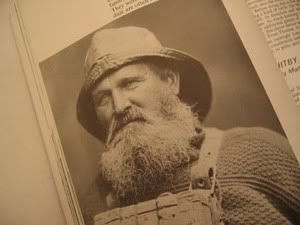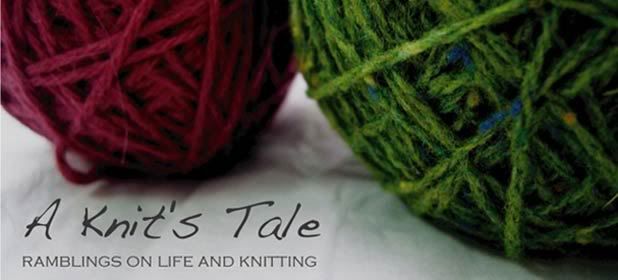I can almost smell the sea
I’ve always been terribly intrigued by cables in knitting. Even though most of the elaborately cabled arans that I have seen resemble the silhouettes of flying squirrels (absolutely adorable on the squirrels but not so much on the human frame), the sight of all that beautiful cable-work still manages to set my heart racing and my hands itching. There’s something so wonderfully substantial and magical about a cable. A few minor alterations in stitch position and out pop an intricate, three-dimensional pattern. How much more amazing could it get? As I followed the Yarn Harlot’s adventures in guernsey-knitting, I bought Gladys Thompson’s book on a whim to learn more about the history of those cable patterns I love so much.

After poring over the book for the past few days, I can effuse endlessly about how terrific it is. Written in the middle of the last century (thank goodness for Dover Publications), the book is a collection of traditional guernsey sweater and stitch patterns, all diligently tracked down by the author in her treks to fishing villages all over Britain.

Her enthusiasm for the subject is readily apparently and quite infectious. How could one resist the delight in her words as she describes the process of hunting for patterns:
Interspersed among the useful stitch patterns from those guernsey hunts are historical details about the fishing villages as well as anecdotes about the knitters and guernsey wearers that Ms. Thompson encountered along the way.

These tidbits of historical context create a wonderful window into that time not so very long ago when knitting was much more than a relaxing hobby. Guernseys had a practical function in keeping fishermen at sea relatively warm and dry. With their close-fitting design, stitch patterns distinctive to village and family, and initials of the owner stitched into the lower sweater body, guernseys also served the darker purpose of allowing for the identification of drowned fishermen. In a time when knitting is more of a fun indulgence than a necessity of life, it’s good to be reminded that it is at its heart, a practical craft. It’s also good to be reminded how lucky we are to be able to knit as an indulgence.
In the face of all that wonderful knitting history and stitch patterns, I was quite inspired to sit down right then and there to design my own guernsey until I realized the little glitch in my impulse. While several sweater patterns are provided in the book, all of the directions are very abbreviated with no diagrams. Certainly decipherable, especially if one is familiar with sweater construction, but a bit of a challenge. So, with my rather limited sweater-making skills as of now, I don’t think I will be attempting a guernsey just yet...maybe in a year or two...

After poring over the book for the past few days, I can effuse endlessly about how terrific it is. Written in the middle of the last century (thank goodness for Dover Publications), the book is a collection of traditional guernsey sweater and stitch patterns, all diligently tracked down by the author in her treks to fishing villages all over Britain.

Her enthusiasm for the subject is readily apparently and quite infectious. How could one resist the delight in her words as she describes the process of hunting for patterns:
“Guernsey hunting becomes rather an obsession, but the search for them is fun – memorizing them off the fisherman’s back or front, (back if he’s baiting lines, painting boats or other engrossing jobs which entail a bending position!) Front, if he’ll talk!
Fortunately, most of the patterns are repetitions, and if a section is memorized, the rest can be worked out on an old envelope round the corner – often the man wanders away before you have taken it all in, then he has to be chased down the sea wall, or harbour, to verify and make certain.”
Interspersed among the useful stitch patterns from those guernsey hunts are historical details about the fishing villages as well as anecdotes about the knitters and guernsey wearers that Ms. Thompson encountered along the way.

These tidbits of historical context create a wonderful window into that time not so very long ago when knitting was much more than a relaxing hobby. Guernseys had a practical function in keeping fishermen at sea relatively warm and dry. With their close-fitting design, stitch patterns distinctive to village and family, and initials of the owner stitched into the lower sweater body, guernseys also served the darker purpose of allowing for the identification of drowned fishermen. In a time when knitting is more of a fun indulgence than a necessity of life, it’s good to be reminded that it is at its heart, a practical craft. It’s also good to be reminded how lucky we are to be able to knit as an indulgence.
In the face of all that wonderful knitting history and stitch patterns, I was quite inspired to sit down right then and there to design my own guernsey until I realized the little glitch in my impulse. While several sweater patterns are provided in the book, all of the directions are very abbreviated with no diagrams. Certainly decipherable, especially if one is familiar with sweater construction, but a bit of a challenge. So, with my rather limited sweater-making skills as of now, I don’t think I will be attempting a guernsey just yet...maybe in a year or two...




3 Comments:
I have this book, too, it's excellent! I love all the anecdotes. But are you saying you don't like most aran sweaters??? I absolutely love all arans and ganseys :)
I love the expression on the fisherman's face. He has a lovely twinkle in his eye.
I love those old knitting history books -- such fun to read, and such inspiration!
Post a Comment
<< Home